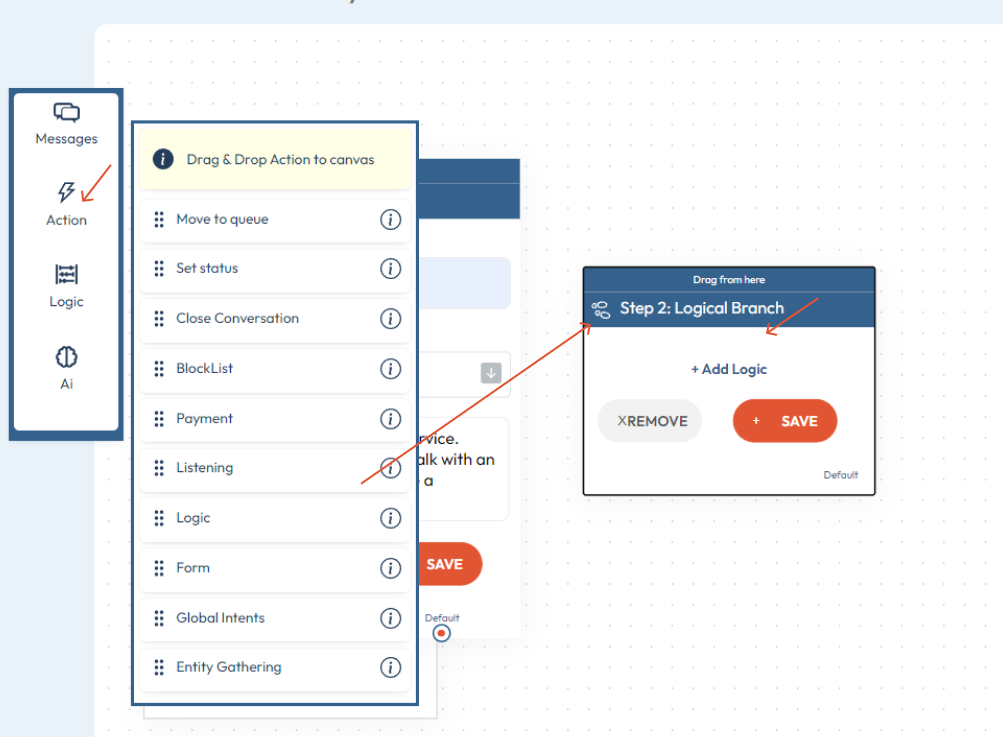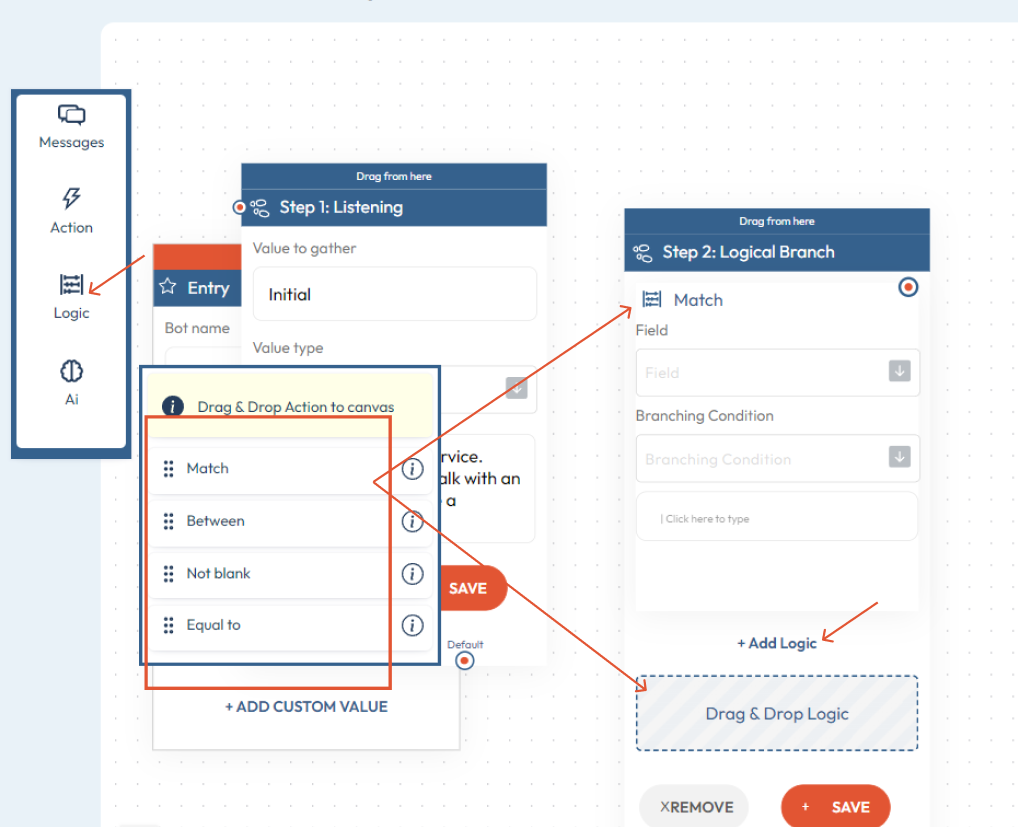Logical Branching
Overview
Logical Branch steps allow you to configure a path through a bot based on the time of day, day of the week, number of connected agents, or customer input.
In addition, using Logical Branch, you can compare values collected from the customer and compare them with those you have imported from your Campaign File (or those that come from the internal system for Webhook integrations) to run ID&V processes and improve the bot's ability to manage inbound flows.
How to configure a Logical Branch step
When building a Bot, from the Action block, drag a Logical Branch step to the bot build screen then click on ADD LOGIC. .
.
This will bring up the Drag&Drop Logic box on the step. Now you can select, from the LOGIC block, the type of logic you want (E.G. Match) and drop it on the Drag & Drop Logic box of the card you have just created.
Configure the card's BRANCHING condition and. Click ADD LOGIC and repeat the process if you want to add additional logics to the step. 
When the step is configured, don't forget to save it. The step is now ready to be integrated into the rest of the Bot's conversation flow.
You will need to configure the paths for the conditions you created, in case they are met, but also configure a default path that the Bot will follow, in case the previous conditions are not met.
Once your Step and your Bot is ready don't forget to hit CREATE BOT (Or UPDATE BOT if you are editing an existing one) at the top right corner of the screen.
In the example below, thanks to the Listening Step (1), we have collected value from the customer. The value is then passed through Logical Branch Step (2), where the "Match" logic checks if the value returned by the customer matches any manual conditions I have configured.
If customer returns:
- "Chat", "CHAT" or "chat" the Bot will progress to Step 3
- "Pay", "PAY" or "pay" the Bot will progress to Step 4
- None of the above, the Bot will progress to Step 5
Types of logics
The available logics that can be used within a Logical Branchare:
Match
The "Match" logic verifies that the field selected in the logical Branch step matches/does not match any of the manual inputs below.
For example, you can collect a value through a Listening Step and then check, with the help of the Logical Branch, whether it matches any of the manual inputs.
In the "value to gather" of the Listening Step, define the field where the value returned by the customer will be stored. In the Logical Branch, the newly collected value can be compared with manual inputs. You can add more than one input, make sure to press the ENTER key on your keyboard when you add a new one, then save the step when you're done.
Between
Add a date comparison to your Bot to check if the date provided falls in an acceptable range. Learn more here.
Not Blank
Equal
Equal Logic gives your Bot the ability to select the fieldname you want to compare, and check if it is:
Equal or Not Equal to a alphanumerical value
- It checks if a stored value is equal or not equal to the alphanumerical value you insert in the VALUE field.
Equal or Not Equal to another #Fieldname#
- You can use equal/not equal logic to check whether or not a stored value is the same as another value stored against the contact. (Used for ID&V processes)
Gather a date of birth through an Entity gathering step, then thanks to Logical Branch, compare the field where you saved customer response (E.G. Reference) with the one you have on your spreadsheet (E.G. DOB)
When performing these kind of comparisons, in the Value field, include # at the start and the end of the fieldname you want to branch on. E.G. #DOB# - <<DOB>> For Webhook Custom Value request
Less or Greater Than a numerical value or another #Fieldname#
- It checks if a customer returned value is less or greater than the numerical value you insert in the VALUE field.
Equal - Branching to system values.
When using Equal, you can also branch to system values such as:
- Current Day
- Current Hrs
- Active Agent
- Route the conversation based on how many agent are active on the queue. Logical Branch - Active Agents (webio.com)
- Time Since Unanswered
- Please refer to Wait Until Condition if you want to configure a re-engager step.
- Payment Type
Multiple true conditions
When, on the same Step, multiple conditions are true, the Bot will follow the first condition that is true, going from the top to the bottom of the card.
In the example below if customer returns in response to Entity Gathering Step 2 E.G. "250", Step 3 will compare the value with the conditions we have set up, in that case, both 1st and 2nd conditions will be true but the Bot will proceed to step 4.
Related Articles
Logical Branching - Adding a date comparison
Overview Logical Branching Date Comparison (Between), verifies that the date provided by the customer falls between today's date and the cut-off date you set, allowing you to ensure the date provided during a conversation is within an acceptable ...Conversation Flow Builder & Step types
Overview From Webio Bots screen, using our drag-and-drop interface, you can create conversation flows. Each "block" represents a piece of the conversation, such as a message, an action or waiting for an user input. When building a bot your can add ...Logical Branch - Active Agents
Overview After a conversation enters a queue, using a Logical Branch step, you can route the conversation based on the number of Webio users that are logged in at the moment that the logical check is happening. Please note that the system is counting ...Webio FAQ
General Why can't I log to my Webio account? If you can't log to your Webio Account, try first to clear your internet browser cache and cookies or to log in from incognito window or a different internet browser (Make sure you are entering your ...Webhooks within your bots (New Web App)
Overview Webhooks allow you to use real time information within your Webio bots. This can be used to provide customers' up to date information within the conversation or to configure logic decisions within your bot based on information provided from ...